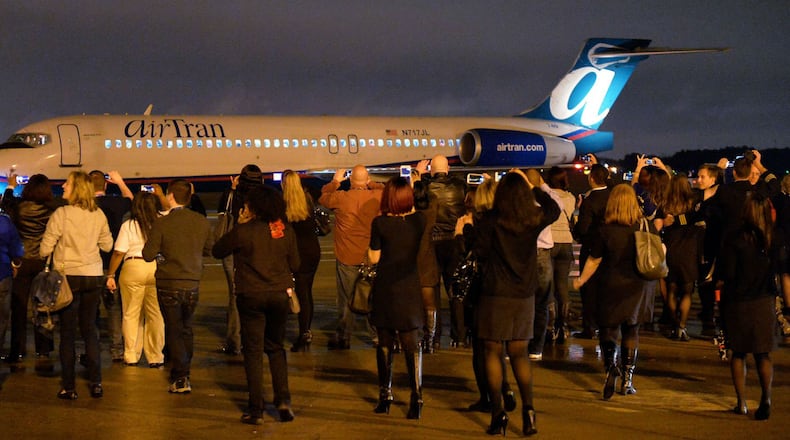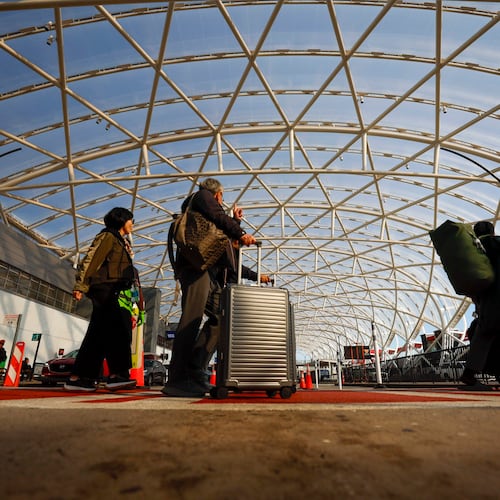AirTran: The beginning and the end
1993: ValuJet Airlines is founded in Atlanta to fill a void after the collapse of Eastern Airlines. AirTran Flight 1 takes off Oct. 26 from gate C26 of Atlanta’s airport, bound for Tampa. The new carrier had two planes and four destinations.
1996: After fast growth and strong financial performance, the crash of ValuJet Flight 592 in the Florida Everglades, killing all 110 aboard, prompts government to temporarily ground the carrier.
1997: ValuJet, struggling since its resumption of service in late 1996, moves to buy a small Orlando-based carrier, AirTran. It takes the AirTran name and Orlando headquarters as part of the merger.
Late 90s-mid-2000s: AirTran grows steadily, buys new planes and expands, gaining recognition as a leading low-cost carrier.
Sept. 27, 2010: Southwest announces it will buy AirTran and enter the Atlanta market by taking over its hub here.
May 2, 2011: Deal closes following shareholder and regulator approval.
August 2011: Southwest announces AirTran route cuts, with more cuts in subsequent months.
Feb. 12, 2012: Southwest launches its first flights from Atlanta.
March 1, 2012: Southwest and AirTran get Federal Aviation Administration clearance to begin combining flight operations.
November 2013: Southwest dismantles AirTran’s hub, converting its flight schedule in Atlanta into an operation focused more on local passengers than connecting traffic.
Nov. 1, 2014: AirTran’s frequent flier program ends. Southwest takes down AirTran signs at Hartsfield-Jackson check-in counter, replacing them with Southwest’s.
Dec. 28, 2014: Last AirTran flight from Atlanta to Tampa brings an end to the AirTran name.
Watch video and see photos of the final AirTran flight on ajc.com.
AirTran Airways, the little airline that made a big difference in Atlanta, has flown its final flight.
“It’s the end of a chapter that was incredibly important for Atlanta,” AirTran frequent flier Joe Leader said, citing the carrier’s two-decade dogfight with Delta Air Lines for the loyalties of Atlanta travelers.
Leader, of Dunwoody, was one of hundreds who jockeyed to be on Sunday night’s last flight. He snagged a seat, but 762 people on the standby list did not. Most were former or current employees or aviation buffs who wanted to be part of history.
AirTran's end culminates a drawn-out merger that began when Southwest Airlines moved to buy the airline four years ago -- one in a wave of mergers that has shrunk the industry's A-list to just four major players.
Southwest has gradually folded AirTran’s operations into its own, repainting planes and replacing logos one by one. It all led to a final roll down the runway as Flight 1 set off Sunday from Atlanta to Tampa, tracing the path of forebear ValuJet Airlines’ first Flight 1, which happened 21 years ago.
“I’m glad it’s being celebrated,” said Scott Doose, who traveled from Little Rock, Ark., to be on the final flight. But, he added, “It’s disappointing to see another airline disappearing in consolidation.”
The celebration started hours before takeoff, when people with ties to AirTran began streaming onto Concourse C, eventually swelling to a crowd of more than 400. Amid the balloon-bedecked gate area at one end of the concourse, a DJ spun music while those who had worked to build the airline and its Atlanta hub reunited, hugged, reminisced and snapped selfies.
‘A new future’
Southwest CEO Gary Kelly, whose company now includes several thousand ex-AirTran workers, preferred a forward-looking spin. He likened the end of the AirTran name with a commencement: “It is the close of an era, but now it is the opening of an all-new future,” he told the crowd.
Some employees dabbed tears as they recounted the long hours, difficulties and victories of helping to grow a feisty, ambitious airline in Delta’s long shadow.
Though headquartered in Orlando, AirTran’s operations base and strategic focus was Atlanta. Many AirTran employees called Delta “The Big D” and AirTran, with its lower-case logo, the “Little A.” But the little airline grew to become a sizable No. 2 airline in Atlanta and one of the nation’s largest low-cost carriers.
“It’s a part of aviation history to be on a final flight of an airline,” said Tana Thomas, a longtime AirTran flight attendant who worked Sunday’s flight. “I get tingles when I think about it.”
The 117-seat Boeing 717 used for the flight was tail number N717JL, an aircraft dedicated to former AirTran CEO Joe Leonard. Employees lined the tarmac and fire trucks sprayed a water cannon salute as the plane taxied away from the gate at 10:25 p.m.
Inside the plane, employees and other passengers sat in near silence, marked by a few sniffles, as they gazed out the window at the people watching from below.
The celebration quickly resumed, though. Passengers cheered as the plane accelerated, cheered the takeoff, cheered the landing. In between, they cheered as the four senior flight attendants served free cocktails and popped bottles of champagne.
Flight attendant Travis Bruce announced upon landing: “Ladies and gentlemen, welcome to Tampa, and the end of an era.”
Hundreds more AirTran fans gathered there. Many came by bus together or drove from Orlando, where AirTran had its headquarters.
“It’s a really bittersweet day,” said flight attendant Will Estrada, who got an AirTran logo tattooed on his wrist after the Southwest deal was announced. “I’m a very sentimental person. I needed something to hold onto,” he said.
Began as ValuJet
The airline that became AirTran started as ValuJet in 1993, when it was launched in Atlanta by four veteran airline executives. ValuJet was a hit with budget-minded fliers and grew rapidly until May 1996, when regulators grounded the airline after Flight 592 crashed in the Florida Everglades, killing all 110 people on board.
After resuming operations but struggling to regain passenger loads and profits, ValuJet acquired the smaller, Orlando-based AirTran and took its name and home address. The carrier also shifted strategy, still pitching low fares but adding business class seats.
By 2007 AirTran was a go-to low-cost carrier for many travelers in Atlanta and around the country, with more than 250 daily departures from Hartsfield-Jackson International.
“It was an incredible success story out of something that could have been an incredible failure,” Leader said.
Two key assets — its Atlanta hub and its international flights to Mexico and the Caribbean — made AirTran a target for Southwest, the Dallas-based discount giant.
Many Atlanta travelers had long wanted Southwest to enter the market, but the effect has been mixed. The merger eliminated AirTran, which offered business class seating while Southwest is all-coach. Average fares in the market are up, and Southwest has chopped the old AirTran flight schedule to about 130 daily departures. It plans to consolidate from two concourses into one at Hartsfield-Jackson in January.
“It’s really a cost-saving plan. It’s much more efficient,” said Bob Jordan, the Southwest executive who’s been in charge of the AirTran takeover. He said Southwest does not plan to shrink any further in Atlanta, and added that Southwest can still serve more local Atlanta passengers than AirTran did due to larger planes and fewer connecting passengers on them.
Former employee Piotr Rolek, a passenger on Sunday’s flight, said AirTran will be remembered as a “scrappy upstart” with an underdog mentality.
“People see what AirTran did with very little,” Rolek said. “I think they’re sentimental about it going away.”
About the Author
Keep Reading
The Latest
Featured



